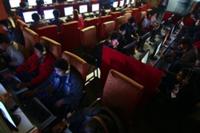

The test wing has a span of 22 feet and a chord of 15 feet. It is built entirely of advanced composite materials and lightweight plastics. Its upper surface is covered with advanced solar cells, which convert sunlight into electricity that would be used to power the aircraft and its payloads.
"Aurora's interest in solar-powered aircraft dates from the earliest days of the company," said Aurora CEO John Langford. "Our very first externally funded study, in 1989, was for a solar-powered version of the Daedalus human-powered aircraft. Today's designs are for much larger aircraft -- literally hundreds of feet in wingspan. The idea of this test panel was to develop and validate designs and manufacturing techniques. Doing this is essential for the accurate planning of any future solar aircraft development program."
In 2008, Aurora was selected as a contractor by DARPA for Phase 1 of the "Vulture" ultra-long endurance aircraft program. Aurora's design, called "Odysseus" uses a unique variable geometry design known as the "Z-wing."
The large solar test panel was privately funded by Aurora as an adjunct to Vulture. In addition to the test panel, Aurora has funded the development and flight test of the SunLight Eagle, a 114 foot wingspan solar UAV which made its first flights in the spring of 2009.
About Aurora Flight Sciences
Aurora Flight Sciences designs and builds robotic aircraft and other advanced aerospace vehicles for scientific and military applications. Aurora is headquartered in Manassas, VA and operates production plants in Bridgeport, WV and Columbus, MS and a Research and Development Center in Cambridge, MA. To view recent press releases and more about Aurora please visit our web site at www.aurora.aero.
Image Available: http://www2.marketwire.com/mw/frame_mw?attachid=1189407
Contact:
Contact:
Patricia Woodside
Director, Public Relations
(703) 396-6304
Email Contact

















No comments:
Post a Comment